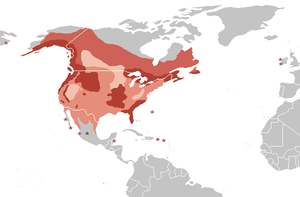Field Guide/Birds/Haliaeetus leucocephalus
| Haliaeetus leucocephalus (Bald Eagle) | |
|---|---|
 |
 |
 |
 |
| Description | |
| The Bald Eagle (Haliaeetus leucocephalus) is a bird of prey found in North America, most recognizable as the national bird of the United States.
The species was on the brink of extinction in the US late in the 20th century, but now has a stable population and is in the process of being removed from the U.S. federal government's list of endangered species. An immature Bald Eagle has speckled brown plumage, the distinctive white head and body developing 2-3 years later, before sexual maturity. This species is distinguishable from the Golden Eagle in that the latter has feathers which extend down the legs. Also, the immature Bald Eagle has more light feathers in the upper arm area, especially around the 'armpit'. Adult females have an average wingspan of about 7 feet (2.1 meters); adult males have a wingspan of 6 ft 6 in (2 meters). Adult females weigh approximately 12.8 lb (5.8 kg), males weigh 9 lb (4.1 kg). The smallest specimens are those from Florida, where an adult male may barely exceed 5 lb (2.3 kg) and a wingspan of 6 feet (1.8 meters). The largest are the Alaskan birds, where large females may exceed 15.5 lb (7 kg) and have a wingspan of approximately 8 feet (2.4 meters). Bald Eagles are powerful fliers, and also soar on thermal convection currents. In the wild, Bald Eagles can live about 20-30 years, and have a maximum life span of approximately 50 years. They generally live longer in captivity, up to 60 years old. Bald Eagles normally squeak and have a shrill cry, punctuated by grunts. They do not make the "eagle scream" as often shown on the television. What many recognize as the call of this species is actually the call of a Red-tailed Hawk dubbed into the film. Bald Eagles build huge nests out of branches, usually in large trees near water. The nest may stretch as large as eight feet across and weigh up to a ton (907kg). When breeding where there are no trees, the Bald Eagle will nest on the ground. Eagles that are old enough to breed often return to the area where they were born. An adult looking for a site is likely to select a spot that contains other breeding Bald Eagles. Bald Eagles are sexually mature at 4 or 5 years old. Eagles produce between one and three eggs per year, but it is rare for all three chicks to successfully fly. Both the male and female take turns sitting on the eggs. The other parent will hunt for food or look for nesting material. | |